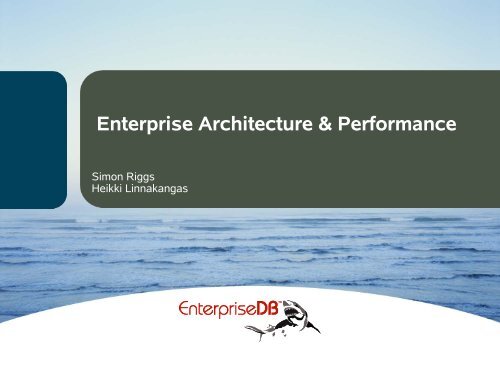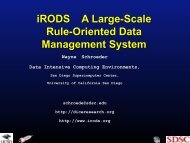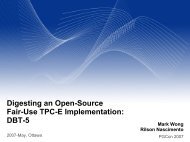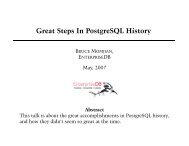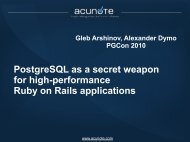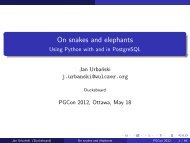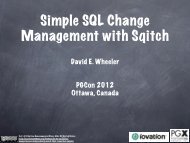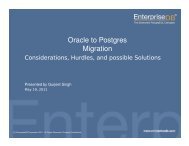Performance Research - Simon Riggs - PGCon
Performance Research - Simon Riggs - PGCon
Performance Research - Simon Riggs - PGCon
You also want an ePaper? Increase the reach of your titles
YUMPU automatically turns print PDFs into web optimized ePapers that Google loves.
Enterprise Architecture & <strong>Performance</strong><br />
<strong>Simon</strong> <strong>Riggs</strong><br />
Heikki Linnakangas
Overview<br />
<strong>Performance</strong> Features in 8.3<br />
<br />
<br />
<br />
Enterprise Architecture Lifecycle<br />
OLTP <strong>Performance</strong><br />
Data Integration & Decision Support <strong>Performance</strong><br />
2 © 2007 EnterpriseDB Corporation
<strong>Performance</strong> Features in PostgreSQL 8.3<br />
HOT for Frequent Updates*<br />
Clustered Indexes*<br />
Database Size Reductions<br />
ComboId, Var Varlena<br />
Checkpoint optimizations<br />
mdsync looping avoidance,<br />
kill CheckpointStartLock<br />
XLog File Switch tuning<br />
<strong>Performance</strong> Logging<br />
log_autovacuum,<br />
log_lock_waits<br />
UnGuaranteed Transactions*<br />
COPY tuning<br />
WAL Reductions<br />
COPY, CLUSTER<br />
B-tree split<br />
Recovery I/O Reduction<br />
ORDER BY ... LIMIT<br />
Merge Join<br />
L2 Cache Tuning*<br />
SeqScan, VACUUM<br />
3 © 2007 EnterpriseDB Corporation
Enterprise Context<br />
Which Use Cases do we need to improve?<br />
Which features do we need?<br />
Examine some real world situations<br />
Understand the trajectory of successful PostgreSQL users<br />
4 © 2007 EnterpriseDB Corporation
Web Site Database<br />
Single Application<br />
Single Database<br />
Early Stage<br />
Business Issues<br />
Web<br />
Time to Market means<br />
incomplete functionality<br />
5 © 2007 EnterpriseDB Corporation
+ Business Sales<br />
Multiple Customer Roles<br />
Additional database tables<br />
New on-line transactions<br />
Consumer<br />
Increased complexity<br />
B2B<br />
More variable response<br />
times, for some cases<br />
6 © 2007 EnterpriseDB Corporation
+ Billing<br />
Business customers want<br />
bill consolidation and<br />
additional value adds<br />
Complex bulk tasks<br />
Very low priority jobs<br />
Long running transactions<br />
Consumer<br />
Billing<br />
B2B<br />
7 © 2007 EnterpriseDB Corporation
+ Marketing<br />
Targeted Marketing<br />
requires off-line analyses<br />
Complex, long running<br />
analysis tasks, some adhoc<br />
analysis<br />
Identification of propensity<br />
to purchase/renew<br />
Pop-up surveys for<br />
customer satisfaction<br />
measurement<br />
Adds complexity to other<br />
transaction types<br />
Consumer<br />
Marketing<br />
Billing<br />
B2B<br />
8 © 2007 EnterpriseDB Corporation
+ Decision Support<br />
Additional analysis<br />
Fraud, Churn, Strategic<br />
Marketing, Strategic<br />
Financial Planning, Due<br />
Diligence<br />
Significant additional<br />
workloads for decision<br />
support<br />
Huge additional data<br />
volumes<br />
Long run times<br />
Consumer<br />
Marketing<br />
Decision<br />
Support<br />
Billing<br />
B2B<br />
9 © 2007 EnterpriseDB Corporation
+ High Availability<br />
Allow for some parts of<br />
these databases to be<br />
accessible even across<br />
hardware outage,<br />
preventative maintenance<br />
and upgrade<br />
Consumer<br />
Marketing<br />
B2B<br />
Decision<br />
Support<br />
Billing<br />
HA<br />
10 © 2007 EnterpriseDB Corporation
+ Regulatory Archive<br />
Requirement for massive<br />
data storage to meet<br />
Government legislation<br />
Access is rare, yet<br />
response time fast when<br />
required<br />
Consumer<br />
Marketing<br />
B2B<br />
Typically small set of<br />
records over a long period<br />
of time<br />
Decision<br />
Support<br />
Regulatory<br />
Archive<br />
Billing<br />
HA<br />
11 © 2007 EnterpriseDB Corporation
Major Forces on Enterprise Architecture<br />
Business Growth<br />
Cost Growth/Reduction<br />
Workload Evolution<br />
Mergers & Acquisitions<br />
12 © 2007 EnterpriseDB Corporation
Workload Evolution (1)<br />
Generic process<br />
Starting from one<br />
reasonably consistent<br />
workload<br />
13 © 2007 EnterpriseDB Corporation
Workload Evolution (2)<br />
New workload starts<br />
Shows up as operational<br />
and/or performance<br />
problems<br />
Typical Responses<br />
“What just happened?”<br />
“How do we tune this?”<br />
“How do we control this?”<br />
“How can we stop this?”<br />
14 © 2007 EnterpriseDB Corporation
Workload Evolution (3)<br />
Workload grows<br />
Recognised as a significantly<br />
different workload<br />
Typical Responses<br />
“Can they co-exist?”<br />
“How do we prioritise?”<br />
“How can we allocate<br />
resources effectively?”<br />
“When to let them run?”<br />
“Can we chargeback?”<br />
15 © 2007 EnterpriseDB Corporation
Workload Evolution (4)<br />
Workload separated<br />
Typical Responses<br />
“Best way to transfer data?”<br />
“How can we keep them as<br />
current as possible?”<br />
“How to reduce the impact on<br />
the source system?”<br />
“How to change the data<br />
model as we move the data?”<br />
“How can we speed up endto-end<br />
load process?”<br />
16 © 2007 EnterpriseDB Corporation
Enterprise Architect's Viewpoint<br />
How can I maintain continuous access to data via web site?<br />
How can offer a worthwhile Service Level Agreement? How<br />
can I do that as the business grows?<br />
Can I consolidate my servers? How do I mix workloads for<br />
as long as possible? How do I approach data integration<br />
between servers?<br />
How can I increase the number of decision support queries<br />
the business runs each month?<br />
How can I mix long term archive with shorter term decision<br />
support requirements?<br />
17 © 2007 EnterpriseDB Corporation
IT Manager's Viewpoint<br />
We mustn't ever lose our critical data<br />
The customer must be able to access their data 24x7<br />
It must be cheap in the long term, not just at the start<br />
I want it to perform well<br />
The decision to use PostgreSQL must be low risk. I'm not<br />
going to let technical favouritism get in the way of my job.<br />
18 © 2007 EnterpriseDB Corporation
What is performance, and what can we hackers do<br />
about?<br />
“I want it to perform well”<br />
<strong>Performance</strong><br />
Steadiness<br />
Throughput<br />
Adaptation<br />
“It must be low-risk” -> Scalability<br />
19 © 2007 EnterpriseDB Corporation
Steadiness matters<br />
Unsteady performance is often worse than consistently poor<br />
performance<br />
“Every now and then the system stops responding, but<br />
revives after a few minutes. What's going on?”<br />
Unsteadiness makes benchmarking harder<br />
Also an availability issue: If the system stops responding,<br />
it's not available<br />
20 © 2007 EnterpriseDB Corporation
Steadiness matters<br />
Benchmark of MySQL and PostgreSQL by PFC, per mail<br />
titled “Postgres Benchmark Results”, 20 May 2007:<br />
21 © 2007 EnterpriseDB Corporation
Sources of unsteadiness: Checkpoints<br />
Load distributed checkpoints patch by Itagaki Takahiro is in<br />
the patch queue<br />
22 © 2007 EnterpriseDB Corporation
Sources of unsteadiness: Vacuum<br />
Vacuum has a significant impact on concurrent activity<br />
vacuum_cost_delay helps, but needs manual tuning<br />
While autovacuum is vacuuming a large table, smaller ones<br />
are neglected<br />
Vacuum doesn't scale nicely<br />
23 © 2007 EnterpriseDB Corporation
Future of Vacuum<br />
Make vacuum cheaper<br />
Dead space map<br />
Skip 2 nd vacuum pass, set xvac in the 1 st phase instead<br />
Piggyback vacuum on normal database activity<br />
Reduce the needed vacuum frequency<br />
HOT<br />
Truncate dead tuples to line pointers<br />
Retail vacuum<br />
Reference counting<br />
24 © 2007 EnterpriseDB Corporation
Sources of unsteadiness: Other queries<br />
Concurrent queries have an impact on other queries<br />
In patch queue<br />
Make buffer cache scan-resistant<br />
synchronized seq scans by Jeff Davis<br />
25 © 2007 EnterpriseDB Corporation
Sources of unsteadiness: Plan Instability<br />
Cached plan becomes ineffective when data changes<br />
A sub-optimal plan is chosen when data changes<br />
Future research:<br />
Invalidate plans when statistics are updated<br />
Improve cost estimates<br />
Assigning a confidence factor to estimates<br />
Estimate hints, like marking tables as volatile<br />
26 © 2007 EnterpriseDB Corporation
Throughput<br />
<strong>Performance</strong><br />
Steadiness<br />
Throughput<br />
Adaptation<br />
27 © 2007 EnterpriseDB Corporation
Adaptation<br />
<strong>Performance</strong><br />
Steadiness<br />
Throughput<br />
Adaptation<br />
Availability<br />
28 © 2007 EnterpriseDB Corporation
Adaptation<br />
“Can we run OLTP and DSS on a single server?”<br />
“I don't want to hire a consultant to tune the system for a<br />
week”<br />
“Out-of-the-box” performance<br />
System needs to adapt to changing workload, without<br />
having to manually change GUC parameters and restarting.<br />
The ultimate goal is to get rid of all performance-related<br />
GUC parameters<br />
29 © 2007 EnterpriseDB Corporation
Adaptation: Memory management<br />
shared_buffers<br />
work_mem<br />
wal_buffers<br />
temp_buffers<br />
max_fsm_pages & max_fsm_relations<br />
30 © 2007 EnterpriseDB Corporation
Adaptation: Background Writer<br />
Autotuning bgwriter options for 8.3:<br />
Greg Smith and Itagaki Takahiro<br />
31 © 2007 EnterpriseDB Corporation
Adaptation: Checkpoints<br />
Requirements for checkpoint_interval and<br />
checkpoint_segments really comes from a more<br />
fundamental business requirement:<br />
Maximum acceptable recovery time<br />
Checkpoint intervals should be expressed in terms of that.<br />
32 © 2007 EnterpriseDB Corporation
Availability<br />
<strong>Performance</strong><br />
Steadiness<br />
Throughput<br />
Adaptation<br />
Availability<br />
33 © 2007 EnterpriseDB Corporation
Availability<br />
“The customer must be able to access their data 24x7”<br />
No maintenance window<br />
Implies a reasonable response time -> steadiness<br />
34 © 2007 EnterpriseDB Corporation
Availability: Recovery time<br />
Faster recovery with full_page_writes=on in 8.3<br />
Future research:<br />
Reducing WAL size<br />
COPY performance (to speed up pg_restore)<br />
35 © 2007 EnterpriseDB Corporation
Availability<br />
Changing parameters<br />
Many parameters need a restart for change to take effect.<br />
Offline maintenance tasks<br />
CLUSTER<br />
VACUUM FULL<br />
CLUSTER is MVCC-safe in 8.3, making it a more viable<br />
alternative to VACUUM FULL.<br />
36 © 2007 EnterpriseDB Corporation
Data Integration & DSS <strong>Performance</strong><br />
Log-based Replication<br />
Reducing cost of data integration<br />
Data Integration and High Availability<br />
Read-only tables<br />
Long term archiving<br />
Optimised partitioning<br />
Increased Referential Integrity performance<br />
37 © 2007 EnterpriseDB Corporation
Summary<br />
Holistic feature planning can help PostgreSQL Hackers<br />
Success trajectories in major Enterprises are a good model<br />
<strong>Performance</strong> is a many headed beast<br />
38 © 2007 EnterpriseDB Corporation


